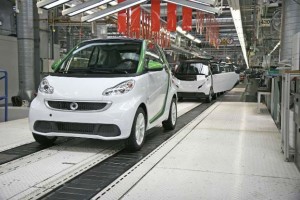Production of the third-generation Smart Electric Drive, or ED, has begun and buyers in Germany will soon be able to plug them into the nearest charging station.
But buyers will have to accept a sharp price increase, about 20% above what Smart officials had indicated just last autumn when they announced plans for the new battery car. But the Gen-3 Smart ED will also get better performance and range than was originally planned.
The new version of the 2-seater will initially launch in Germany but is expected to then roll out in 30 other markets, including North America.
Just last September, Smart CEO Annette Winkler had indicated, “We are offering the new electric smart within our sale&care model for considerably less than EUR 16,000 before tax – plus less than EUR 60 per month for battery rental.”
Our friends at Autoblog Green worked that out to $19,990 and $75, respectively. Unfortunately, the 2013 Smart ED will be launched at EUR 18,910, or $23,625 at the current exchange rate, with the batteries adding another EUR 65, or $81. To buy the car outright will cost a German customer EUR 23,680, or $29,586.
That’s for the Smart ED Coupe. Add about $4,000 to those prices for the Cabriolet.
Meanwhile, website HybridCars is reporting the Canadian price tag will be $26,990 for the Coupe and $29,990 for the Smart ED Cabriolet. We’ve yet to confirm plans for the U.S. market.
A problem with the earlier versions of the ED was that they could barely make U.S. highway speeds. The new model will be capable of hitting 75 mph thanks to an upgraded electric motor. It nominally makes 30 kWh, or 40 horsepower, but can briefly hit a peak 55 kWh, or 74 hp.
The new Smart ED should be reasonable peppy, at least in city driving, launching from 0 to 30 in just 4.8 seconds. As with many electrics, it then starts to bog down a bit, which may be why Smart isn’t releasing 0 to 60 times.
The 17.6 kilowatt-hour lithium-ion battery pack, meanwhile, is capable of delivering up to 90 miles range in urban driving based on the European test cycle. That number is typically quite a bit shorter when a vehicle is run through the U.S. EPA test cycle.
Like the rest of the Smart line, the new Electric Drive is being produced at the maker’s plant in Hambach, France. The plant is being expanded in advance of the much-awaited debut of an all-new version of the Smart fortwo (and the ED model) which is being developed as part of a joint venture between parent Daimler AG and France’s Renault. It is due to market in 2014.
“The new smart electric drive and the expansion of the Hambach plant are two important milestones for the future of smart”, said Smart CEO Winkler. “With the new smart electric drive we are further expanding our leading position in urban mobility and making fully electric driving accessible to everyone. For this – and for the successor generation to the current smart – we are making significant investments in the Hambach site. And I am convinced that this is money extremely well invested.”

